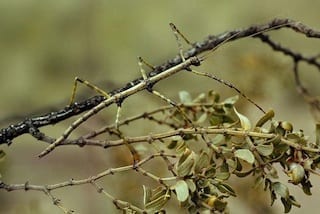In advance of winter, Vanaprastha teams with reproductive activity, from oak trees peppering the ground with acorns to unseen frogs calling availability in chorus from the treetops, a little Leisure-Suit Larry romancing the large female orb-weaver at our back door to a pair of walking sticks clasped in copulo out front. Some encounters are quick and deadly, as was the case with rebuffed Larry, but other relationships, like our walking sticks’, are slow and lengthy. One day their antennae-entwined cleaving was almost stationary; the next, still coupled, they ambled legs in tandem across the front windows. After some research, I discovered that this mating was not only a part of the walking stick’s lifecycle, but also a movement in the symphony of forest survival.
Phasmatodea are masters of camouflage, disguising themselves as twigs or leaves, feigning motionless death or rocking with the breeze to avoid detection by birds or predator wasps. Some varieties have further defense mechanisms such as a display of startlingly bright colors, loud sounds, and wings for flight. Others attack with spiny legs or irritating, distasteful secretions. Lengthy coupling also seems to be a factor in walking stick defense: the male protects his territory from other males and guards the female from predators. Together, two sticks are hard to beat. But before we cheer, let us note that these phasmids as herbivores prey on leaves, and their offspring could defoliate the forest. 
For everything there is a season. There is a time to sit still and a time to rock with the breeze; a time to blend in and the time to change color; a time to prevent attack and a time to defend; a time to plant seeds and a time to die.
During our time on earth, we humans experience a broader dimension of endeavors compared to oaks, frogs, spiders and walking sticks. But perhaps we have much in common with these phantoms of the forest and much to learn from them.
What do you think?



0 Comments